With unseasonably high temperatures this past week, spring flowers are developing fruits and summer flowers are blooming strong throughout the southern end of Jackson Hole. These same species will have encores over the next week or so in the northern valley and into Yellowstone National Park.
Here are some of the most common and obvious wildflowers blooming in sagebrush dominated flats and hillsides. We hope you will enjoy learning some plant names and how flowers are designed to attract pollinators. Enjoy the amazing diversity and beauty of plants.
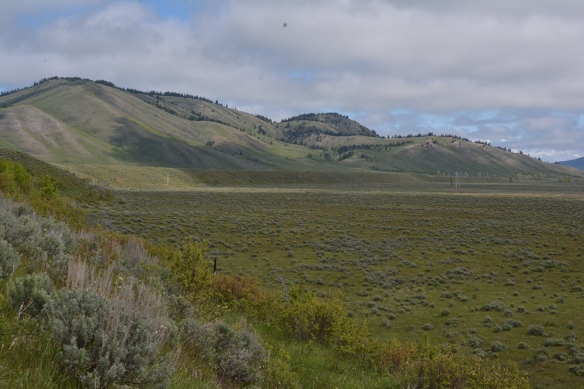
Yellow composites:
Arrow-leaf Balsamroot – Balsamorhiza sagittata – is the big showy “composite” seen on hillsides and sageflats right now. The large flower heads illustrate the typical features of the Aster or Sunflower Family. This is one of the largest flower families in the word with 1000s of intriguing variations which have evolved for success.
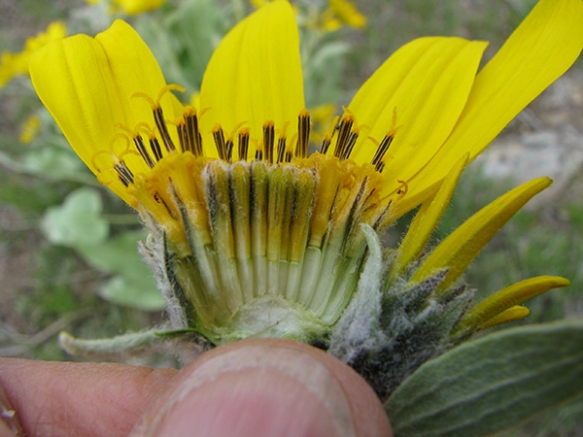
A cross-section of a Arrow-leaf Balsamroot flower head.
Around the outside of the so-called flower head, bright yellow “petals” are actually individual “ray” flowers with five fused petals flattened to one side. The “disc” flowers in the center are tiny flowers with 5 connected yellowish petals forming a flared tube. Above each, a dark column of anthers wraps around an emerging stigma which arches into two parts, ready to capture pollen from visiting pollinators. (Note the outer disc flowers are in full bloom, the inner are still in bud.) Hairy, silvery bracts surround the flat platform or “receptacle” holding the many individual flowers. (If this is too much information, just have fun looking closely!)

Arrow-leaf Balsamroot has one flower head on each 1.5’ stem. The large leaves are arrow-shaped with silvery hairs and arise from the base of the plant.
Don’t confuse Balsamroot with the soon-to-flower Mule’s Ears – Wyethia amplexicaulis.

Mule’s Ears have large, deep yellow flowers with smooth bracts, and 12-18″ oval, deep green leaves which can grow along the stems. They grow in heavier soils than Balsamroot.
Western Groundsel – Senecio integerrimus – has several yellow flower heads with both ray and disc flowers on single stems. The plants usually grow to 8-12”. 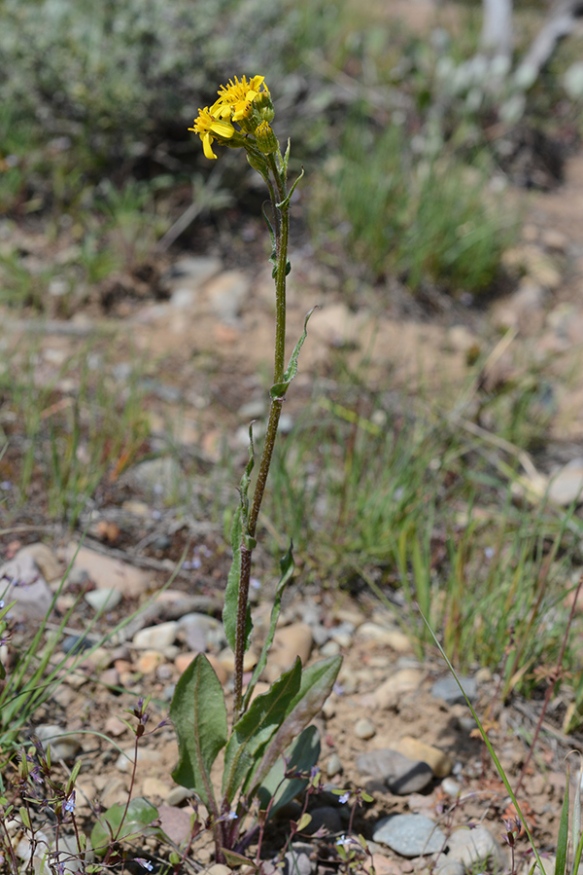

In Groundsels, bracts are all the same length – like a palisade fence – and are black tipped.

Along with these other features, cobwebby hairs on leaves and stem provide definitive ID of Western Groundsel.
At first glance, three other composites look like Common Dandelions – Taraxacum officinale. They grow about 6-8” (or more) tall and have showy yellow heads with only ray or “ligulate” flowers. Look closely at bracts, number of flower heads, and the location and shape of leaves.
The fruits are very helpful in understanding why the taxonomists separate these genera. However, we have to wait until they ripen. Practice by looking at dandelion fluff and fruits.

Common Dandelion has all “ligulate” or “ray” flowers. Notice the leaves are all at the base (basal).

Note the two rows of bracts in Dandelions: bracts of the outer row fold down, those of the inner row are upright. Bracts are very helpful clues in ID of look-alike composite flowers.
False Dandelion – Agoseris glauca – also has only one head per plant. The bracts are variable. Leaves are all at the base or “basal.” Three varieties with different leaves and hairiness to the bracts are a challenge to botanists.
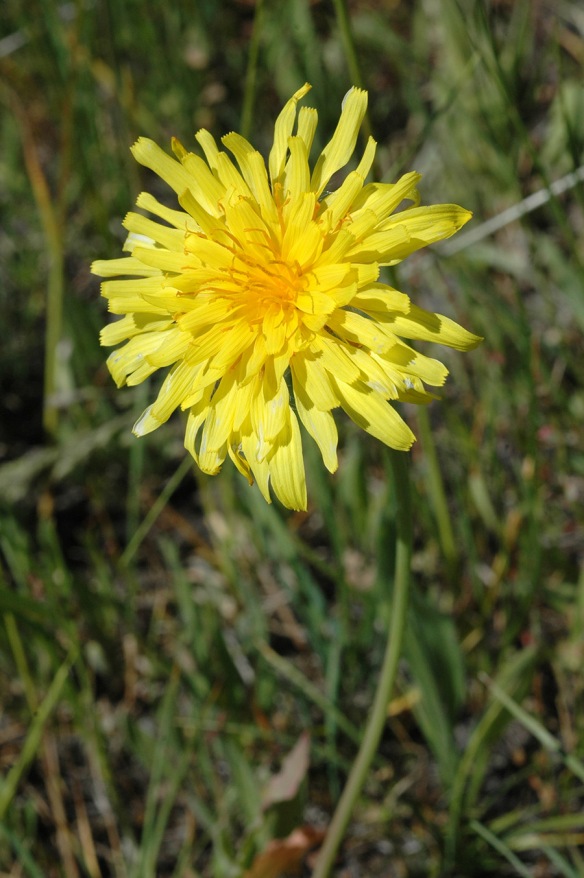
Mountain Dandelion – Agoseris glauca – looks very much like a dandelion, but look closely….

Mountain Dandelions have tidy, upward pointing bracts around each flower head. Some bracts can be hairy or smooth, depending on variety. Leaves vary, too.
Nodding Microseris – Microseris nutans – is very similar to the above, but again look closely: there is often more than one flower per stem or plant and buds typically nod. Leaves are mostly basal, but one or two may attach to the stem, as well.
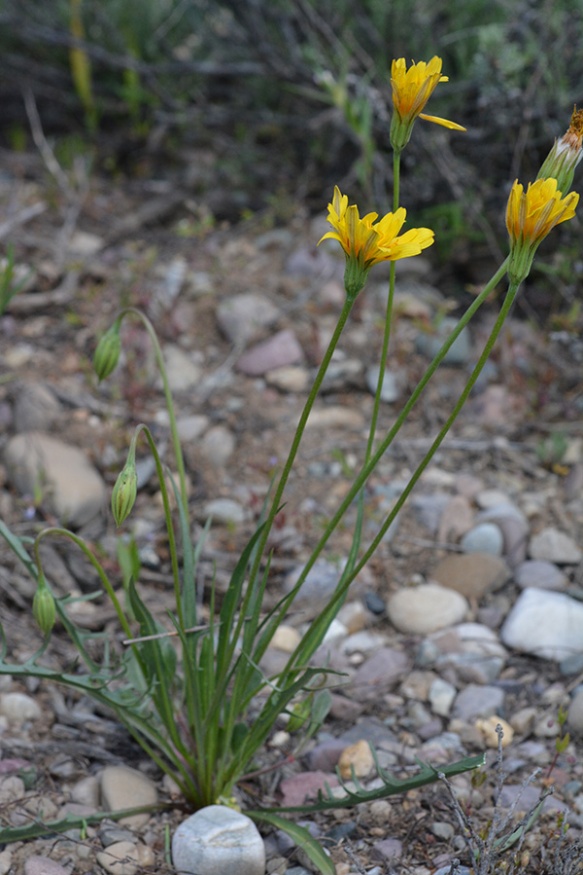
Observe how Nodding Microseris differs from the other species. Note the nodding buds.
Coming into bloom are several species of Hawksbeard – Crepis sp.
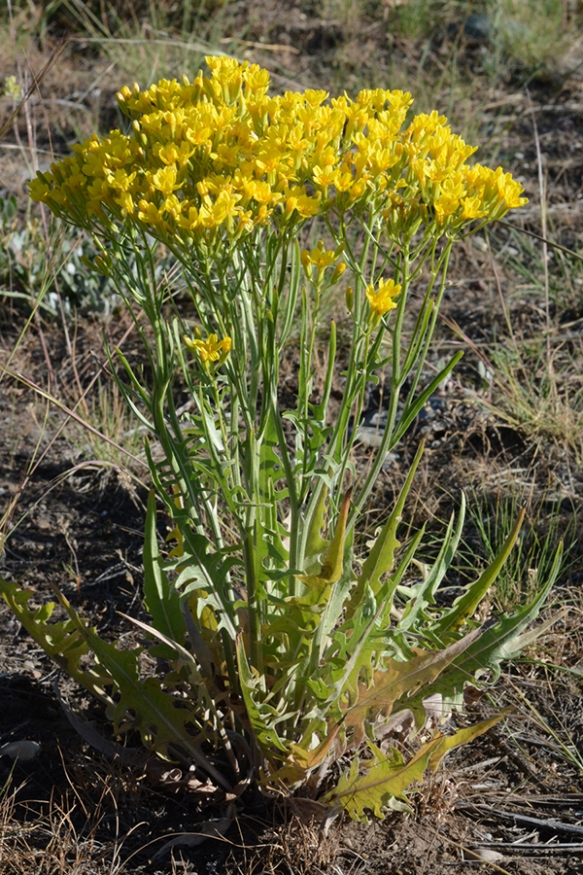
Hawksbeards – Crepis sp. – are robust plants found in sageflats. The leaves bunch at the base but also grow up the branching 8-16” stems. The leaves are often sword shaped and variably pinnately toothed, lobed, or dissected.

In Hawksbeards, the number of flower heads varies, as does the number of individual ray flowers per head. Some species have stiff hairs,which can be black. All these features are used for ID the 3-4 species common in Jackson Hole.
Don’t miss the blues:
Low or Nuttall’s Larkspur– Delphinium nuttallianum – has been blooming for a while. It attracts queen bumble bees, solitary bees, and in some places hummingbirds as pollinators.

Nuttall’s Larkspur is still blooming strong.
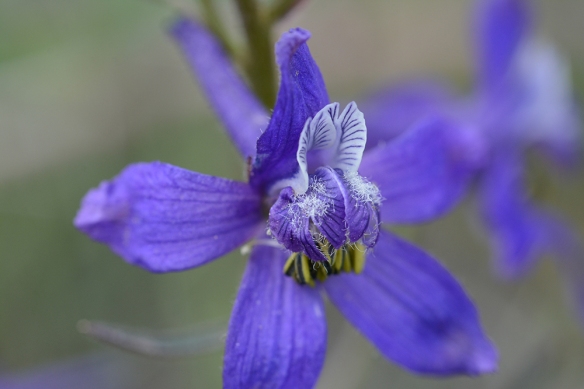
Larkspur flowers are intriguing: 5 deep blue-purple sepals flare out at the sides. The upper sepal forms a long tube behind called a “spur.” Four petals are designed to guide the pollinator into the center of the plant. The two white upper petals are stiff and sport blue “nectar guides.” Each of these petals extends back into the sepal spur and holds nectar as a reward for savvy pollinators. The lower two hairy blue petals flop down, shielding the anthers while also providing landing pads for insect pollinators.
At the right time, anthers shed pollen upon pushy pollinators. The pollinators, after a drink of nectar, fly off to a similar flower and with luck (for the plant) knocks the transported pollen onto the three receptive stigmas. Pollination and, hopefully, the formation of seeds has begun!
Mountain Bluebells – Mertensia viridis/oblongifolia – often grow on grassy slopes and amidst sage plants. Pollinators – bees, butterflies, and hummingbirds – are attracted at first to the curved bunch of pink and blue flowers.
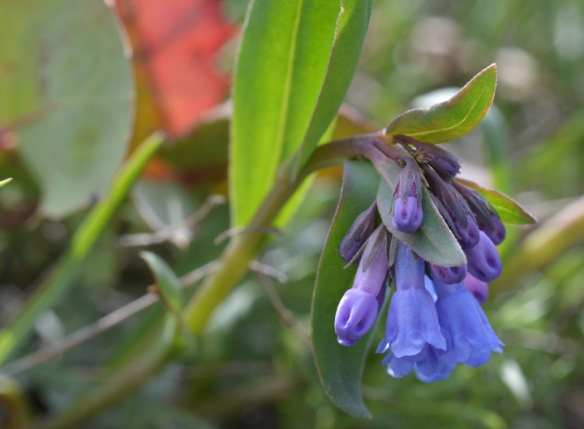
Pollinators zero in on individual blue flowers, where they hang or hover while reaching down the tube for nectar. Watch the color changes of the flowers as they ripen and then fade in the course of pollination and for what insects show up!
Long-leaved Phlox – Phlox longifolia – grows taller and looser than earlier blooming white phloxes which are mat forming, such as Hood’s and Many-flowered Phloxes.
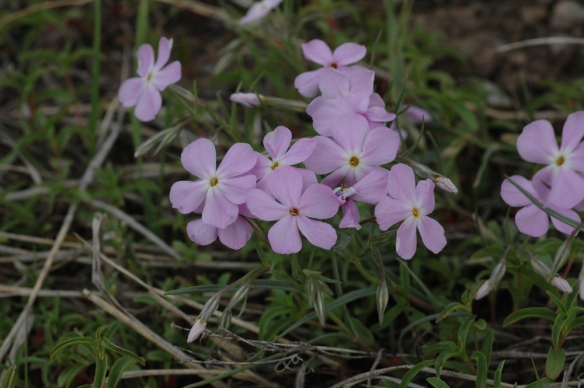
Flowers of Long-leaved Phlox range in color from white to pink to bluish. The are often 4-6″ tall with 1″ leaves.
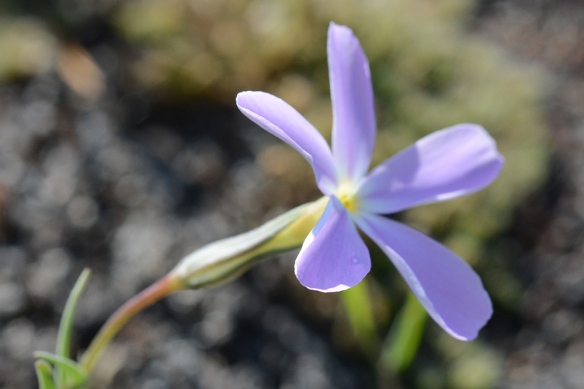
A beguiling fragrance attracts small flies, bee flies, and butterflies to the bluish to pinkish 5-petaled flowers. Only the insects with just the right length mouthparts can reach down the long tube to nectar deep within. Coincidentally, the flower is pollinated.
Other dashes of color:
Prairie Smoke—Geum triflorum – is a member of the Rose Family. The leaves are about 4-6” long, and are “pinnately” (like a feather) dissected–looking “fern-like (although ferns are a whole different order of plants). Leaves cluster plentifully at the base of the spreading plants.

Prairie Smoke has many divided leaves and stalks dangling three flowers (hence the botanical name “triflorum“).
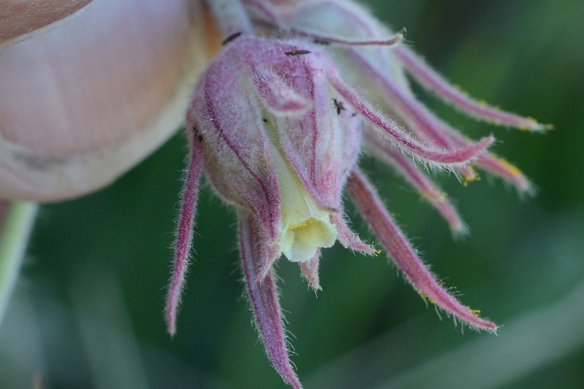
Five fused maroon sepals (with extra bracteoles) surround the pale yellow petals of Prairie Smoke. Together they protect many anthers and pistils inside.
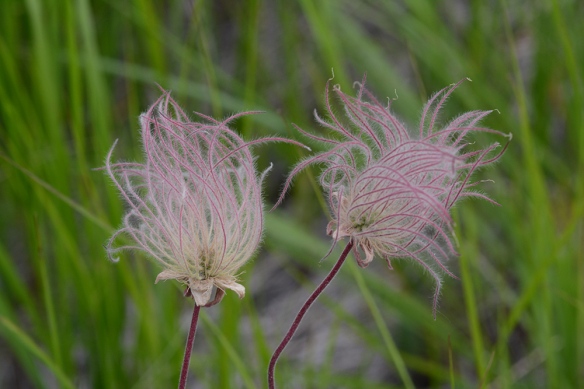
After pollination, each of many pistils mature into feathery fruits, to fly off in the breezes. The heads look like a “bad hair day.” Many fruits together provide the “prairie smoke” effect.
Puccoon, Stoneseed, Gromwell – Lithospermum ruderale – is a robust plant in the Borage Family.
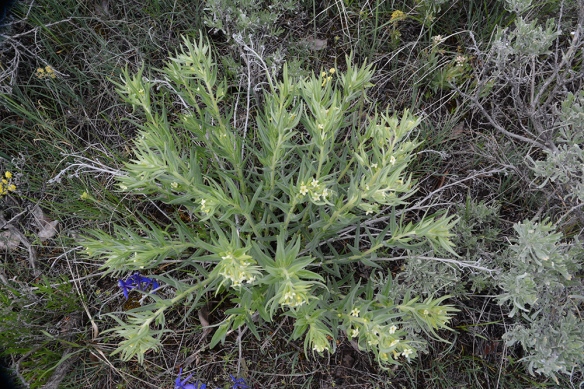
Flowers of Stoneseed – Lithospermum ruderale – are held in the axils of the 1-3″ linear leaves on 1-2′ stems.
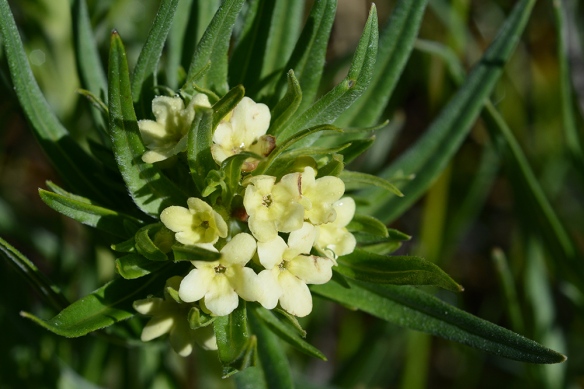
The pale yellow flowers have a delicate lemon-like fragrance, worth bending down for a sniff. They attract bumblebees, hawkmoths, solitary bees, and flies.

Later, flowers will form white fruits with very tough seeds inside…hence the botanical name, which translates into “stone seed.” The seeds are readily predated by deer mice.
Many peoples have used this plant for a variety of medicinal purposes, a reason why it has so many common names.
Three particularly abundant species:
Wyeth Biscuit Root – Lomatium ambiguum – with its wide spreading “umbels” of tiny bright yellow flowers is still growing in abundance at the Sawmill Pond Overlook and along the inner park road.
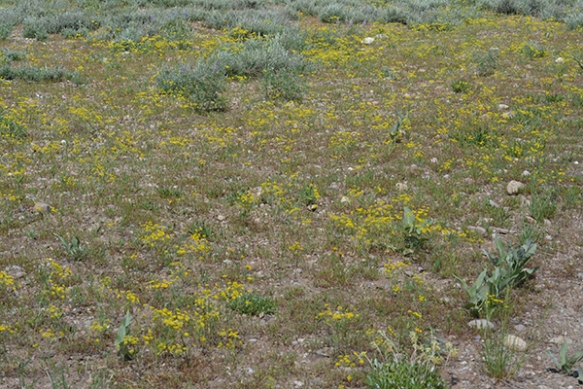
Wyeth Biscuit Root – Lomatium ambiguum – grows along dry, disturbed road sides in the park.
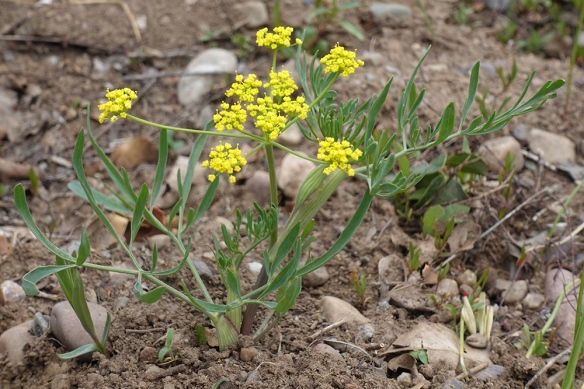
The tiny bright yellow flowers are in umbels (think umbrellas) typical of the Parsley Family. The leaves are dissected into at least 9 segments of various lengths and width. Note the swollen leaf bases.
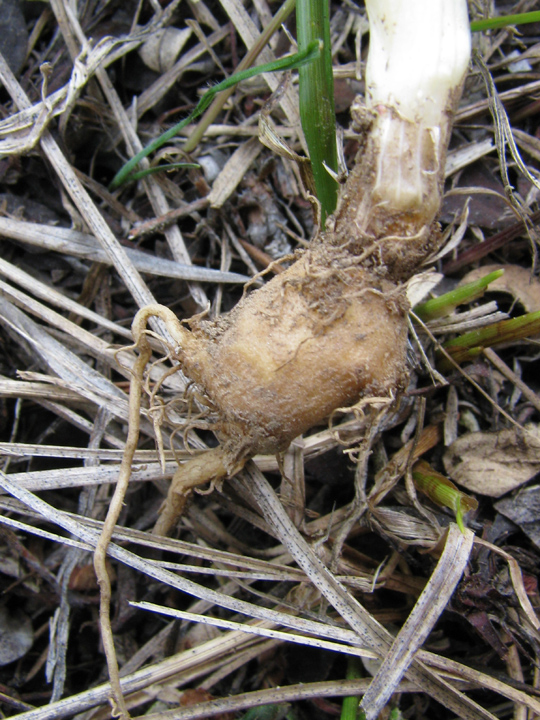
The tuber-like roots were eaten by Native Americans and are sought after by rodents and bears.
It is easy at first to confuse Wyeth Biscuit Root with its more obscure relative. Nine-leaf Spring Parsley – Lomatium simplex var. simplex – has pale yellow flowers and leaves dissected into 9 long, thin segments of equal width and length.

Note the grayish 9-parted leaves and the pale yellow flowers (which will spread into wider umbels) on Nine-leaf Spring Parsley.
Western Valerian – Valeriana occidentalis – appears in almost every habitat – grassy hillsides, near wetlands, and sage flats. While some promote Valerian as a sleep aide, it contains very toxic chemicals. Plants develop such chemicals for defense. Always research carefully any “medicinal” herbs.
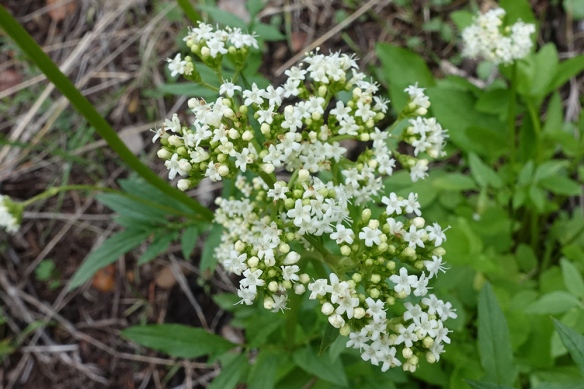
Note the tiny flowers of Western Valerian. In the field, observe how the clusters are held in an “candle-arbor like” arrangement.
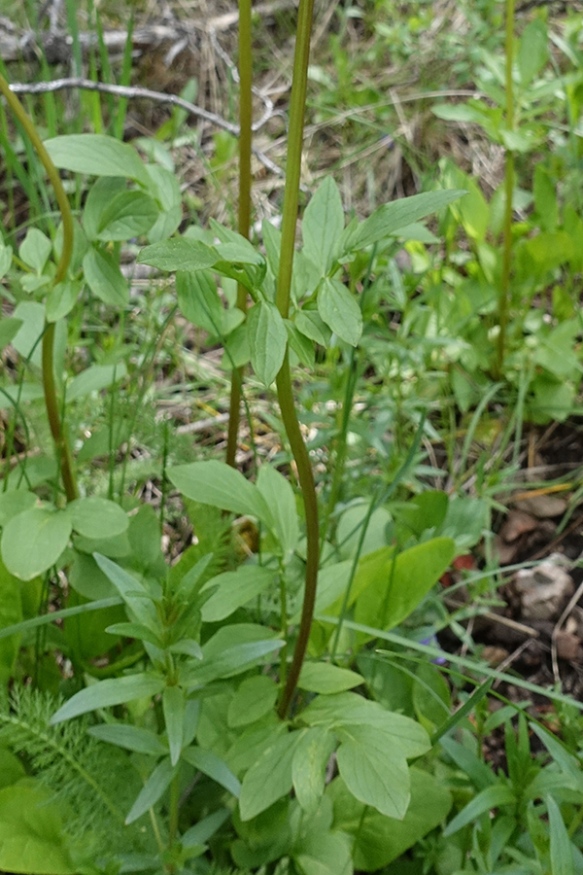
Leaves on the stem are opposite and pinnately compound. Those at the base are usually undivided ovals.
Bright white Field Chickweed – Cerastium arvense – is found often in disturbed habitats.
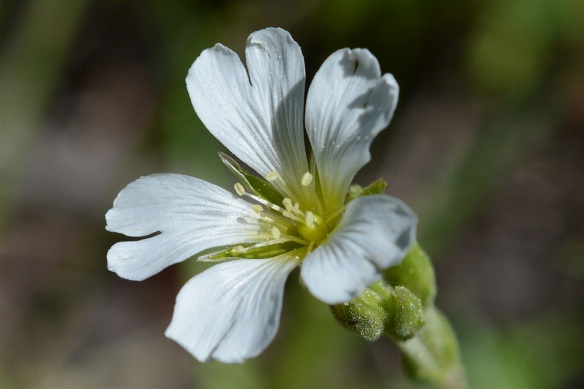
Each petal of Field Chickweed is notched at the tip. Can you count the number of anthers and styles in the center?

The sharp-pointed, needle-like leaves are opposite on the 6-8” stems and often have extra leaves in the axils, which help distinguish it from Bering Chickweed – C. beeringianum – of subalpine and alpine habitats.
Many more flowers are in bloom on dry knolls and hillsides and in relatively moist forest edges. And new flowers will continue to bloom in the flats. We will post additional information soon.
Frances Clark
Wilson, WY – June 10, 2016
P.S. Of particular note at this moment of writing, is the phenomenal amount of pollen being shed by Lodgepole Pines (and perhaps other conifers.) The photo taken in the Lamar Valley three days ago is representative of what is happening all around us now.
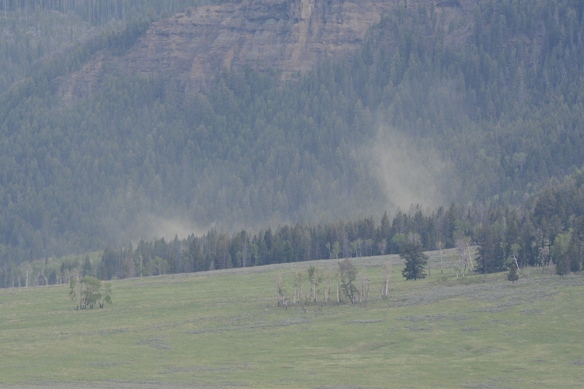
Pine pollen looks like a fire starting in Yellowstone’s Lamar Valley on June 6, 2016. Expect a big cone year in fall 2017.
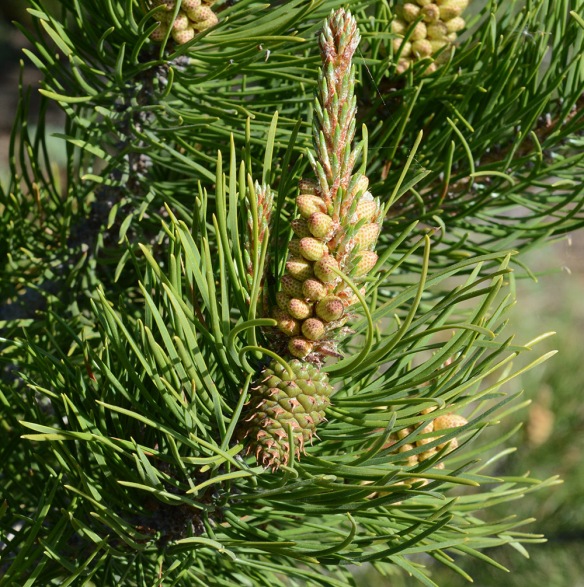
In this photo, the stack of male pine “cones” will soon shed thousands of pollen grains upon the wind and, with lot of luck, pollen will land on separate female cones. However, pine seeds be ripe until 18 months from now. The green female cone shown here is from last spring’s pollen event.

Great post , as usual, Frances. I enjoyed learning more about these particular plants and the photos are great. The one of the pine pollen looks very “sneezy”.
It was reminding me of our amazing trip to the Teton Valley and Yellowstone of two years ago. What a trip of a lifetime that was.
all the best,
Denise
Can someone help me with these following questions, please?1. How do scientists construct models of the sun?2. Describe how electromagnetic energy generated at the center of the sun reaches earth.3. What evidence do we have for solar convection?4. Why have scientists been trying so hard to detect solar neutrinos?5. What would we observe on earth if the sun’s internal energy source suddenly shut off? Would the sun darken intsantaneously? If not, how long do you it might take minutes, days, years, millions of years-for the sun’s light to begin to fade? Repeat the question for solar neutrinos.
The sun is actually really small and much closer to earth. It circles us like the moon does. We do not move.There are tons of videos about this. Try searching Eric Dubay on youtube, He is great at explaining all this.
Frances, thank you for your post. Informative, great photos and narrative. This will help TCD in our ongoing range monitoring.
fabulous photos and explanation of what we are seeing.
Bien çà , un article sur cette vieille Gulbe. Je ne suis pas si eniuthsoaste que cela quand je le vois saborder des rencontres bien engagées mais il faut reconnaître qu’il a quelque chose. Je reviendrai plus tard car j’ai un Letton sur le feu mais j’ai le temps de glisser mes déceptions : Almagro, pour son bras vengeur mais jamais récompensé et Nalbide pour son bras fluide monté sur un corps de Bavarois.